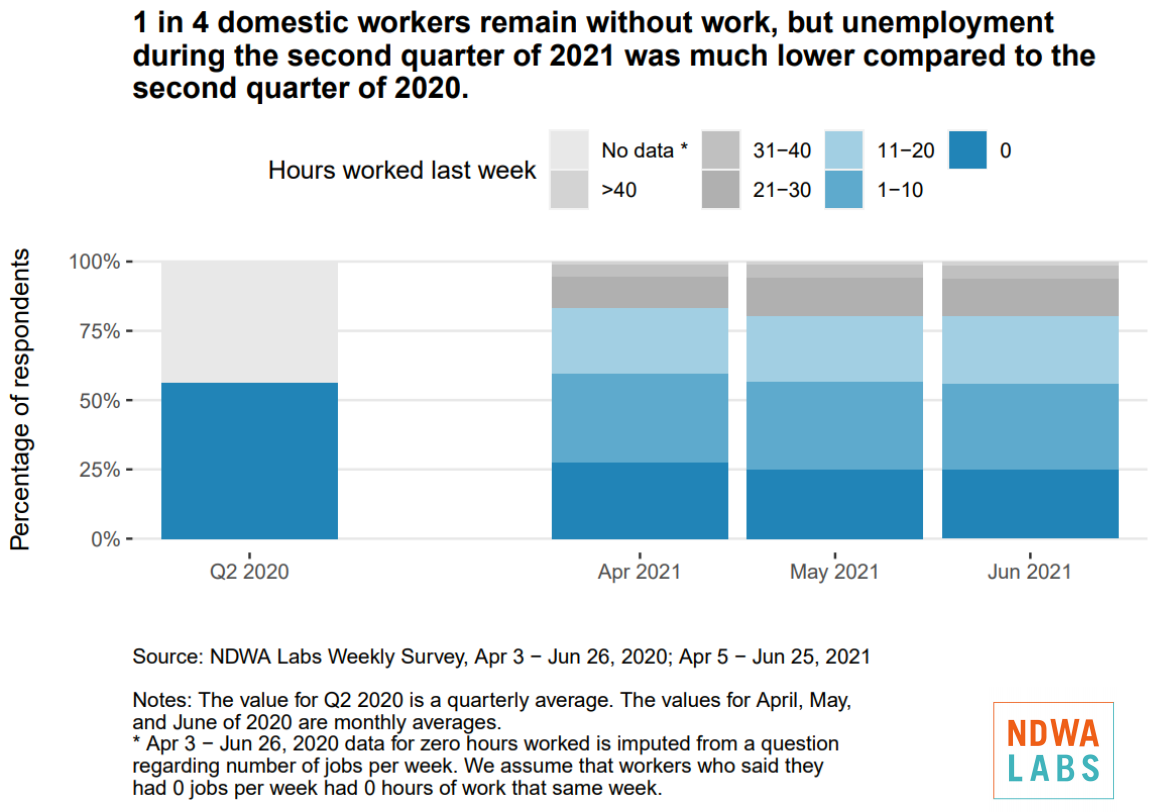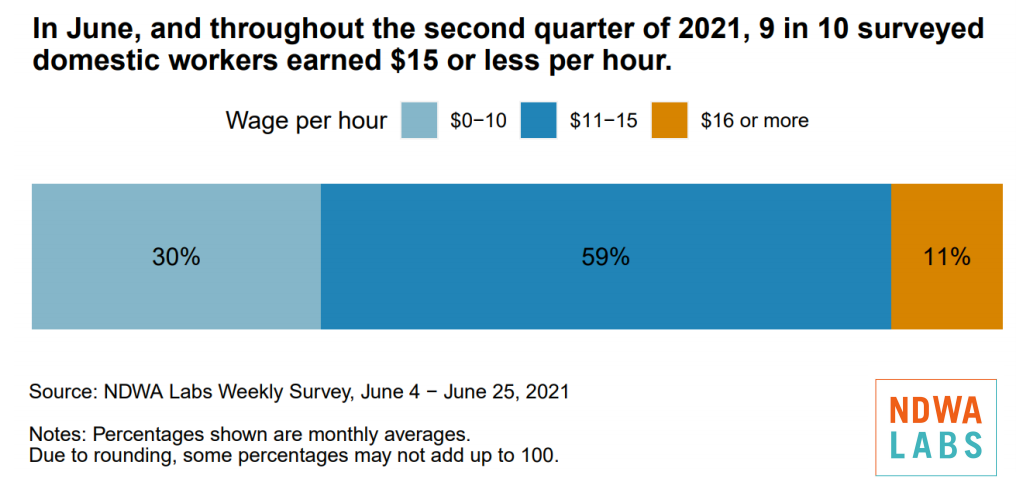DOMESTIC WORKERS’ JOBLESSNESS REMAINED AT 25% DURING JUNE
Unemployment in the second quarter was much lower than in the second quarter of 2020
Domestic Workers Economic Situation Report · June 2021
With analysis for second quarter of 2021
Source: La Alianza surveys, NDWA Labs
Released: July 2, 2021
Today’s Bureau of Labor Statistics Jobs Report shows the unemployment rates for Black and Latinx adults ticked up in June 2021 — and remain higher than before the pandemic and higher than for other demographic groups. NDWA Labs’ June Report shows a similar trend: unemployment is still very high for Spanish-speaking domestic workers, and the percentage of jobless respondents in June was unchanged compared to May. In June 2021, 25% of domestic worker respondents were still out of work, much higher than the 9% who reported having no jobs before COVID-19.
For the first time in this report, we present quarterly comparisons between the second quarter of 2021 (April, May, June) and the same quarter in 2020 for certain indicators.
27% of respondents were out of work on average during this quarter, compared to 57% of respondents during the second quarter of 2020.
While there has been some job recovery, domestic workers are far from achieving economic security.
In the second quarter of 2021, half of respondents faced housing insecurity, and over 3 in 4 faced some level of food insecurity. This represents only a modest recovery compared to the second quarter of 2020.
Domestic workers are the nannies, homecare workers, and house cleaners whose work is essential to our economy, and yet they are one of the most vulnerable and marginalized groups of workers. Even before COVID-19, domestic workers earned less than the average US worker and were three times as likely to be living in poverty.1
La Alianza survey data of Spanish-speaking domestic workers shows how the pandemic has amplified the vulnerability of this workforce. Domestic workers continue to face low wages and high levels of unemployment and underemployment. A contextual note regarding our findings: domestic workers, and particularly house cleaners, often have multiple employers. This means they may have to schedule several jobs in a given week in order to make ends meet.
June Jobs Report - Bureau of Labor Statistics
Each month, the US Bureau of Labor Statistics (BLS) releases an Economic Situation Summary with employment and other labor market data. This is an important report to keep track of how the economy is doing. However, domestic workers, along with other vulnerable workers, are often underrepresented in official data. Here we present an overview of the BLS Jobs report, along with NDWA Labs’ data which shows the employment and economic situation of thousands of Spanish-speaking domestic workers.
On July 2, the BLS released new employment data for June 2021.
The unemployment rates for Black and Latina women ticked up in June 2021.
The unemployment rates for Black and Latinx adults continue to be higher compared to the rates for White and Asian adults.
People who have been unemployed long-term (27 weeks or more) represented 42.1% of the total unemployed in June.
The economic crisis that resulted from the COVID-19 pandemic has been particularly harsh for Latina and Black women. In April 2020, the unemployment rate for Latina women reached 20%, the highest compared to other demographic groups. The unemployment rate for Latina women increased in June 2021 with respect to May 2021, and remains among the highest compared to other demographic groups.2
NDWA Labs’ June Report shows a similar trend: Unemployment is still very high for Spanish-speaking domestic workers, and the percentage of jobless respondents in June was unchanged compared to May. In June 2021, 25% of domestic worker respondents were still out of work, much higher than the 9% who reported having no jobs before COVID-19.
June Domestic Worker Jobs and Wages
June unemployment and underemployment for domestic workers continue to be very high, with 25% of respondents reporting having zero weekly work hours. However, the unemployment we have seen throughout the second quarter of 2021 is much lower compared to the same quarter in 2020.
25% of domestic worker respondents had ZERO work hours per week in June; the same was true in May, compared to 29% in April.
As the second quarter of 2021 came to a close, we saw that 27% of respondents were unemployed on average during this quarter, compared to 57% of respondents during the second quarter of 2020.3
More than 8 in 10 respondents who had work in June were underemployed. Similar to what we saw in May, 82% of domestic worker respondents who had at least one hour of work per week said they wanted to work more hours.
During the second quarter and during June of 2021, an average of 9 in 10 domestic worker respondents earned $15 or less per hour.
Job Search
Most domestic worker respondents, whether or not they had current work, looked for additional work in June.
More than 8 in 10 (83%) domestic worker respondents, whether or not they had current work, told us they had looked for new work in the past 30 days.
Similarly, more than 8 in 10 (81%) respondents, whether or not they had current work, told us they had asked at least one of their regular employers to go back to work in the past 30 days.
Housing and Food Security
Half of domestic worker respondents faced housing insecurity, and more than 3 in 4 experienced food insecurity. While some domestic workers are starting to recover some of the work they had lost, this is not enough to ensure their economic security. Their ongoing economic precarity is reflected in the high number of workers who are unsure if they can afford, or who cannot afford, food in the next two weeks, as well as the high number who are unable to pay rent.
During the second quarter of 2021, half of domestic worker respondents, on average, said they were unable to pay their monthly rent or mortgage. This is only a slight improvement compared to the second quarter of 2020, when an average of 56% of respondents said they were unable to pay their monthly rent or mortgage.
During the second quarter of 2021, an average of 15% of respondents said they would not be able to afford food in the following two weeks and 62% were unsure if they would be able to.
Comparatively, during the second quarter of 2020, an average of 30% of respondents said they would not be able to afford food in the following two weeks and 52% were unsure if they would be able to.
About the surveys
La Alianza surveys Spanish-speaking domestic workers each week, via a Messenger chatbot. The employment numbers presented in this report include data from all our weekly surveys from April through June (Quarter 2) 2021. June averages reflect data from four weekly surveys in June 2021. Questions about hours worked and hourly wages are asked weekly, questions regarding underemployment and job search are asked bi-weekly. Questions around food and housing security are asked once a month.
The second quarter of 2021 data in this report corresponds to 8,451 unique respondents. The total number of fully completed surveys for our four June weekly surveys, which includes both new and repeated respondents, was 5,221; for May, we had 4,123 completed surveys, and 7,685 for April. At the end of each survey, La Alianza provides respondents with relevant news articles and resources in Spanish. To learn more about the La Alianza survey of Spanish-speaking domestic workers, see our recent report.
La Alianza is a product of NDWA Labs, the innovation partner of the National Domestic Workers Alliance. NDWA Labs experiments with the ways technology can organize domestic workers and transform domestic work jobs into good jobs by bringing respect, living wages, and benefits to an undervalued and vulnerable part of the economy.
For questions, please contact us here.
Notes
1 Economic Policy Institute (2019), Domestic Workers Chartbook
2 Economic Policy Institute (2021), Jobs and Unemployment, “A more comprehensive look at unemployment rates”
3 In 2020, our main indicator for unemployment was based on those who responded ZERO to the question: “How many jobs did you have last week?” In 2021, our main indicator of unemployment is based on those who responded ZERO to the question: “How many hours did you work last week?”




